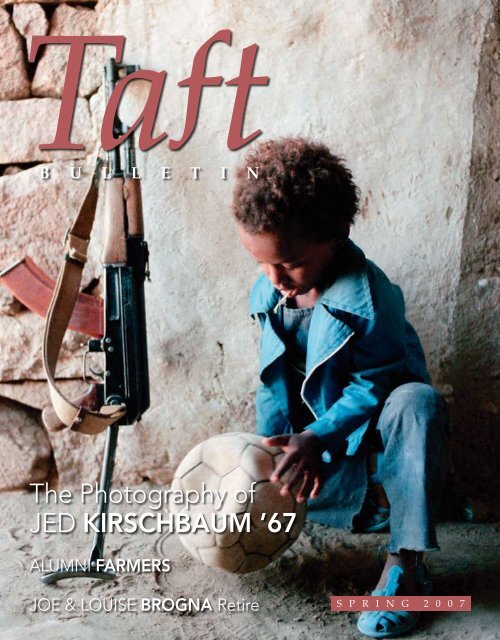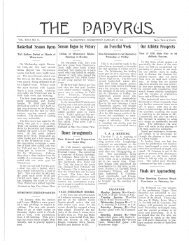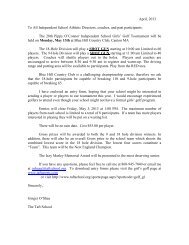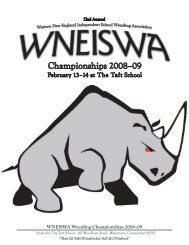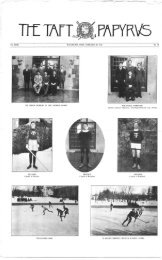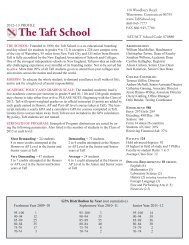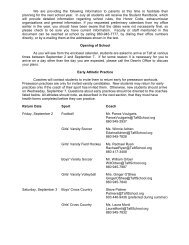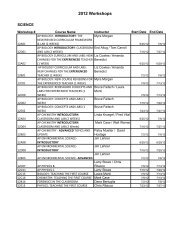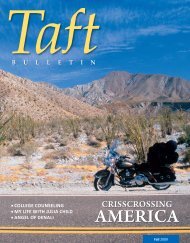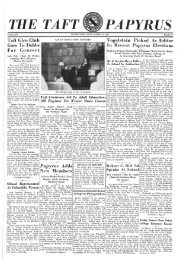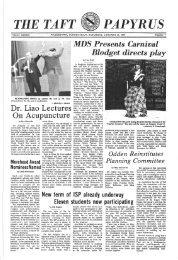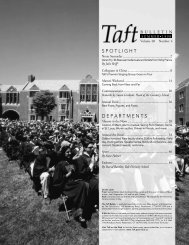The Photography of Jed Kirschbaum '67 - The Taft School
The Photography of Jed Kirschbaum '67 - The Taft School
The Photography of Jed Kirschbaum '67 - The Taft School
- No tags were found...
You also want an ePaper? Increase the reach of your titles
YUMPU automatically turns print PDFs into web optimized ePapers that Google loves.
630j Jessica Ng ’08 and Macie Winship’07 paint a mural at La EscuelaJohn F. Kennedy while volunteeringat Orphanage Outreach in theDominican Republic in March. Thiswas the third year Spanish teacherand Volunteer Program adviserRoberto d'Erizans organized theservice-oriented option for studentsover spring break. Enyi-Abal Koene26F E AT U R E SWriting with Light.................................. 18Baltimore Sun photographer <strong>Jed</strong> <strong>Kirschbaum</strong> ’67 says henever tries to take a picture, he always tries to give one.Alumni Farmers:..................................... 23• Family Trees: Lyman Orchards’ Connecticut Legacy• Herbal Remedy: Ted Andrews ’72• Believe in Your Meat: An alumni couple find theircalling raising grass-fed cattleJoe and Louise Brogna.......................... 30Three Decades <strong>of</strong> <strong>Taft</strong> ServiceD E P A R T M E N T SLetters.................................................... 2Alumni Spotlight.................................... 3Around the Pond .................................. 8Sport ..................................................... 15From the Archives.................................. 35Remembering HoraceON THE COVER: Baltimore Sun photographer <strong>Jed</strong><strong>Kirschbaum</strong> ‘67 came upon this young boy in war-tornEritrea in the 1980s. For more on <strong>Jed</strong>’s work, see page 18.<strong>Taft</strong> on the WebFind a friend’s address or lookup back issues <strong>of</strong> the Bulletin atwww.<strong>Taft</strong>Alumni.comFor more campus news and events,including admissions information,visit www.<strong>Taft</strong><strong>School</strong>.orgWhat happened at thisafternoon’s game?Visit www.<strong>Taft</strong>Sports.comDon’t forget you can shop onlineat www.<strong>Taft</strong>Store.com800.995.8238 or 860.945.7736
L E T T E R S<strong>The</strong> PeachI just received the winter issue, and whenI turned to the inside there was JuddieConant [“Victory Mail”], who was a beau<strong>of</strong> my mother’s! On the first page <strong>of</strong> thearticle, I could even see in his handwriting,“You will have to meet Ann “Rookie” Faustfrom St. Louis, my best girl. She is reallysuper.” My mother! So sweet.I always go and touch his photo [inLincoln Lobby] whenever I come to <strong>Taft</strong>. Ifirst noticed it, I think, when my son Sam’05 was a senior and I wondered if it couldbe the same man. And now there he is. Wefound some letters from him years ago, butmy grandmother decided to burn them becauseshe didn’t think they were appropriatefor anyone else to see. How wonderfulFrom the EditorWhen I arrived at <strong>Taft</strong> in July 1988,the school had just broken groundfor a new dormitory to celebrate theschool’s Centennial. When the dormopened in 1989, Louise and JoeBrogna, who retire this spring (seepage 30), chose to give up their houseon North Street and move in alongside41 upperschool girls. Louise, aregistered nurse, has run the dormever since.Not many faculty live in thedorms for 18 years (and that’s onlythis go-round). I’ve never askedLouise why they made the move, orwhy they stayed—even though I nowlive on the other end <strong>of</strong> the buildingfrom them—but perhaps it has somethingto do with the proximity to theBaseball Field.In Joe’s honor, the AlumniBaseball Game is back on the schedulefor Alumni Day. So whether you cometo play or to watch, it’s a wonderfulopportunity to say “hello,” “goodbye,”or simply “thank you.” It’s the end <strong>of</strong>an era after all.I am thrilled by the number <strong>of</strong>letters we received after the winter issue;I hope you keep them coming!—Julie Reiffthat you have these and what a treat to seemy mother’s name right there.Now I have even more reason tovisit Juddie. My mother, who died quiteyoung, rarely talked about him, but Igather he was a remarkable, sweet, good,kind man. I just wanted to say how thrillingit was to see him and to see her name,so thank you.—Mary Dangremond P’05,’10A Friend in FerdieI’ve just read the winter Bulletin in whichI fondly encountered the article on myclassmate Ferdie Wandelt. I valued Ferdie’sfriendship as a student and have enjoyedour reunions. His accomplishments are anunsurprising testament to his character, insightand common sense.Many have praised Ferdie with moreexperience and skill than I can attempt.I respond, however, because I so enjoyedthe writing that, on finishing the piece, Iturned back to the beginning to see whoachieved the feat <strong>of</strong> so engagingly wadingthrough the range <strong>of</strong> material that Ferdie’scareer has generated. I should have guessedthat Barclay Johnson ’53, my <strong>Taft</strong> Englishteacher, was still displaying his talent.Bravo, Barclay, for your wonderfulwork on a wonderful fellow.—Mike Cutler ’66<strong>Taft</strong> TriviaDo you know?Although many women were a big part <strong>of</strong>school life from the early days, includingWinnie <strong>Taft</strong> and later Nurse Grant, it wasmany years before any woman joined theranks <strong>of</strong> the faculty. Can you name <strong>Taft</strong>’sfirst female teacher?A <strong>Taft</strong> key ring will be sent to the winner,whose name will be drawn at randomfrom all correct entries received by June 1.Becca Fine ’04 was the winner <strong>of</strong> theprevious question, correctly identifyingtoday’s McIntosh House as the formerMartin Infirmary, or “Grant’s Tomb.”Thanks to all who replied.Love it? Hate it?Read it? Tell us!We’d love to hear what you think aboutthe stories in this Bulletin. We may edityour letters for length, clarity and content,but please write!Julie Reiff, editor<strong>Taft</strong> Bulletin110 Woodbury RoadWatertown, CT 06795-2100orReiffJ@<strong>Taft</strong><strong>School</strong>.orgHow the CookieCrumblesI read Peggy Rambach’s article about theHydrox with great interest, and noticedthat in all these years <strong>of</strong> hearing about thegroup, the naming story has never beenfully rendered. But now it can be told—Inamed the Hydrox.Huh? What’d he say?Yup. And in the spirit <strong>of</strong> MelanieGriffith in Working Girl (remember the elevatorscene where she explains her thoughtprocess and saves her job?) I will now takeyou through the steps that led to this event.Back then I was a theater nerd. Thatyear, it was Boys From Syracuse, which I—continued on page 38 <strong>Taft</strong> Bulletin Spring 2007
<strong>The</strong> Philanthropistsm Elsie and Henry withtheir <strong>of</strong>fspring.Courtesy <strong>of</strong><strong>The</strong> Hillman Foundationb Both Henry’s andElsie’s families spentsummers at Beaumaris,a Canadian town onLake Muskoka wherethey first met.Courtesy <strong>of</strong><strong>The</strong> Hillman FoundationIf you live in Pittsburgh, you know thename Hillman. So it’s with the greatesthonor that Pittsburgh Magazine namedElsie and Henry Hillman ’37 theirPittsburghers <strong>of</strong> the Year in January. <strong>The</strong>Hillmans’ philanthropy is legendary:<strong>The</strong> Hillman Library at the University<strong>of</strong> Pittsburgh, Hillman Hall <strong>of</strong> Mineralsand Gems at Carnegie Museum <strong>of</strong>Natural History, Hillman Cancer Centerat University <strong>of</strong> Pittsburgh MedicalCenter, Hillman Center for PediatricTransplantation at Children’s Hospital<strong>of</strong> Pittsburgh, Hillman Fellows Programfor Innovative Cancer Research, andthe list goes on.Having both lost loved ones tocancer, their support in that field is understandable,but the spark <strong>of</strong> their generositygoes much deeper. Henry spentmore than 40 years on the board atChildren’s Hospital. “It opened my eyesto what philanthropy can do,” he toldPittsburgh Magazine. “At that time, hospitalswere much more dependent formoney on gifts from the outside world.<strong>The</strong>re was no Medicare or Medicaid.”<strong>The</strong> Hillman family first moved toPittsburgh after the Civil War, whenHenry’s grandfather started a coal andcoke brokerage in 1886, later expandinginto coal mines and river transportation.Armed with a geology degree fromPrinceton and 12 weeks at Harvard’s advancedbusiness program, Henry tookover the family company after his fatherdied and eventually evolved it into theinvestment firm he runs today.Elsie and Henry are hoping to instillsimilar values in their grandchildren.In addition to their own foundation,they have established philanthropicfoundations for each <strong>of</strong> theirfour children, nine grandchildren, andtwo great-grandchildren (so far).“Living in Pittsburgh has been a tremendouspleasure for both <strong>of</strong> us,” addsHenry, “We never wanted to move.”<strong>Taft</strong> Bulletin Spring 2007
Clothing designer Melissa Lee Madden‘91, center, with Kristin Williams ‘01 andBecky Belcher ‘97 at the MAGIC tradeshow in Las Vegas last AugustTimeless Preppywith a TwistWhile working in the corporate arena,Melissa Madden ’91—also known asMelly Mads—designed and createdunique apparel and accessories for herfamily and friends, who consistently encouragedher to turn that talent into a career.She heeded their advice, and MellyM was founded in the spring <strong>of</strong> 2003.Madden began to produce preppy,sophisticated skirts and handbags,and her merchandise began to sellmore quickly than she could produceit. After her first NYC trade show, sherealized she had found her calling andsoon hired two production houses toassist with manufacturing.Melly M collection has evolvedto include dresses, bustiers and accessoriesas well as skirts and handbags,now found in more than 300 boutiquesin the United States. Maddendesigns and prints all her own fabricand continues to seek out unconventionalcolor palettes to keep her clothingdistinctive and timeless.Melly M’s products have been spottedon many celebrities, listed in suchmagazines as In Style, Brides, Women’sWear Daily, Golf For Women, and featuredin Oprah’s “O List.” Madden was also featuredon the Today Show’s Style File.Madden was asked to showcaseher wares at Smashbox Studios DesignSuites in Los Angeles during the everpopularMercedes-Benz Fashion Weekannual runway shows in March. She isventuring into a line <strong>of</strong> bridesmaids’dresses, coming this fall.For more information, visit www.mellym.com.Curry Named Beanpot MVPAfter leading Boston University men’sice hockey team to its third straightBeanpot title, in addition to clinchinghome ice for the league quarterfinals,senior John Curry ’03 (Shorewood,Minn.) was named Hockey East ITECHGoaltender <strong>of</strong> the Month and is theirnominee for the Hobey Baker Award.Curry posted a .947 save percentageand a 1.63 goals-against averagein February and was undefeated in hisfirst seven starts in the month, helpingthe Terriers move back into the top fivein the national rankings for the firsttime since October.In the Beanpot, Curry earned MVPhonors and set a tournament record witha .985 save percentage and made 37 savesin a thrilling 2–1 overtime victory overrival Boston College in the championshipgame. He will finish his career witha perfect 5–0 record in the Beanpot.For more on Curry, please visitCurryForHobey.com.. John Curry ’03 is the only goaltender in the country ranked in the top three in bothsave percentage (.933) and goals against average (1.86). Courtesy <strong>of</strong> Boston University <strong>Taft</strong> Bulletin Spring 2007
<strong>The</strong> French Bread Connectionb Brandy Dailey and Frank Riordan ’35work together to make French baguetteswith a recipe from Charlie van Over ’56.Karen Elshout/St. Louis Post-DispatchRetired chemical engineer Frank Riordan’35 has had incidental and long-termrelationships with many <strong>of</strong> the giants <strong>of</strong>the food world, but his latest passion isfor a French bread recipe from Charlievan Over ’56, author <strong>of</strong> <strong>The</strong> Best Bread Ever.It was another <strong>Taft</strong>ie—development<strong>of</strong>ficer Chip Spencer ’56, whohappens to have been Charlie’s roommateat <strong>Taft</strong>—who introduced the two.A series <strong>of</strong> illnesses has largely confinedRiordan to a wheelchair, but with the help<strong>of</strong> a caregiver, he regularly bakes bread,recreating the French baguettes he soenjoyed on trips to Europe for Monsanto.After apprenticing in the kitchen <strong>of</strong>France’s renowned Troisgros, Riordanlater hosted the Troisgros brothers inSt. Louis.“I can tell you,” Riordan told theSt. Louis Post-Dispatch, “a dinner invitationto the Riordan household then wasnever turned down.”Starting Up in ShanghaiEver wonder if you’d find a use for whatyou studied in high school? LearningChinese with Yen Liu has come in handy forNestor Gounaris ’89, who recently openedhis own firm in Shanghai. Limelight StudiosStarting a new business can be dauntingin any country, but for lawyer NestorGounaris ’89 establishing his own practicewas simply the logical next choice.Having worked as a corporate lawyerfor large multinational law firms inShanghai for a number <strong>of</strong> years, he hada solid grasp on the basics.“Part <strong>of</strong> the challenge—and benefit—<strong>of</strong>being in a smaller outpost <strong>of</strong>ficeis that you have to sink-or-swim,as there is not much hierarchy betweenyou and the client,” he explains. “As aresult, you can quickly become the leadingattorney on a given matter. Juniorlawyers are driven to mature quickly inthis environment.”Starting China Solutions (www.chinasolutions.us) in April 2005, his clientsnow include the Greek ConsulateGeneral in Shanghai as well as Greekmanufacturers, ship owners, retail operatorsand agricultural producers. “Ithas been such a privilege to connectwith Greek clients—helping me feel athome in Shanghai,” says Gounaris, whohas roots in Greece, “but we also haveclients from around the globe, includingSouth Africa, Denmark, Italy, andthe United States.Having lived in China for overeight years, Gounaris enjoys working inGreece or New York for weeks on end.“Being in a wholly different environment,connecting in person with clients,”he explains, “it’s revitalizing.”<strong>The</strong> hardest part <strong>of</strong> striking out onhis own was not having a safety net.“Suddenly the onus was on me to findsufficient clients, ensure motivation forteam members, appropriate work environment,and so on. Once you get pastthe fear <strong>of</strong> failure, though, the challengesare the best part.“Things have changed quite a bitsince I first started, with our first clientin our first <strong>of</strong>fice. Those first days almostseem quaint. Maybe in another year, Iwill find nostalgic humor in them, butnot quite yet.”<strong>Taft</strong> Bulletin Spring 2007
Spiffy SpaceDay Brigham ’44 and his wife Catherine wereon hand for the dedication <strong>of</strong> the remodeledHeadmaster’s Conference Room, the cost<strong>of</strong> which they underwrote. Some alumnimay remember the space as the Dean’sOffice, where Messrs. McIntosh, Douglas,and Oscarson presided in turn. Adjacentto the Headmaster’s Office, the room holdsfrequent meetings and occasional lunchesfor honored guests. Peter Frew ’75Winter Alumni gamesAlumni Hockey Teamc From back left, faculty Mike Aroestyand Jason BreMiller, Paul Kessenich ’88,Jordy Davis ’91, Gary Rogers ’83, PeteMaro ’83, Chris Watson ’91, Casey Archer’86, Tucker Cavanaugh ’86, Ed Travers ’86,John Long ’88, Matt Donaldson ’88, MattLieber ’88, Jamie Better ’79, CourtneyWemyss ’78. Front, Tim Cooney ’90, ScottRichardson ’82, Willy MacMullen ’78, ChrisTaccetta ’83, Greg Seitz ’86, Fred Erdman’71, Eric Hidy ’93, Jon Lieber ’91, DavidBetter, Wilkie Bushby ’76, Christy Everett’90, and faculty emeritus Jol Everett.Alumni Basketball Teamc From back left, faculty John Piacenzaand Dave Hinman ’87, Jon Dodd ’92,Tyler Whitley ’04, Adam Kowalsky ’03,Brian Baudinet ’04, David Kilborn ’86,Ben Andrysick ’05, Phil Thompson ’06,Dave Halas ’05, and faculty Carl Carlson.Front, Rob Hicks ’92, Victor Smith ’06,Hunter Serenbetz ’06, Pat McCormack’92, Andrew Svensk ’94, Jon Willson ’82,Brandon Miles ’03.in thegalleryArtist Ken Rush ’67displays his recentwork in the MarkPotter ’48 Galleryfrom April 20through May 19.b Vacant,33" x 48",oil on canvasCourtesy <strong>of</strong> KatharinaRich Perlow Gallery<strong>Taft</strong> Bulletin Spring 2007
Around the pondSarah Amos Gallery ExhibitOn January 12, Rockwell VisitingArtist Sarah Amos opened a show in thePotter Gallery. Currently a full-time studioartist, Amos taught printmaking atDartmouth College and spent ten yearsas the Director <strong>of</strong> the Vermont StudioCenter Press. Amos specializes in printmaking,and she displayed a number<strong>of</strong> richly layered pieces. She overlaysher prints with dynamic and colorfulpainted patterns resonant <strong>of</strong> the indigenousart <strong>of</strong> her native Australia, windingand threading lines, dots, and circlesthrough the work to create a unifiedstructure. Amos <strong>of</strong>ten lays the successivelayers <strong>of</strong> pattern while the previouslayer is still wet, causing a blending effectbetween the different levels <strong>of</strong> her Chickadaunce describes her work asjuxtapositions. Gallery director Louetapieces. Through s<strong>of</strong>t, repetitive shapes “seductively intelligent,” and praises theand quiet color, her finished pieces createsubtle color boundaries and tonal In addition to displaying herartist as “a superb artist and teacher.”work,Soya Seo ’09 works with master printmaker Sarah Amos. Loueta ChickadaunceAmos spent the day at <strong>Taft</strong>, teachingprintmaking skills to AP and AdvancedStudio Art classes.For more information, visit www.sarahamos.com.Decoding the Language <strong>of</strong> ElephantsGrunts, groans, even the sound <strong>of</strong> trumpets—theseare just some <strong>of</strong> the sounds Project, which records and analyzes theis the founder <strong>of</strong> the Elephant Voicesthat elephants make. <strong>Taft</strong> hosted Dr. Joyce various sounds that African elephantsPoole ’74 as part <strong>of</strong> the Paduano Lecture make, in an attempt to understand theirSeries on Philosophy and Ethics. Poole behavior and communication. PooleDr. Joyce Poole ’74 talks about her work with elephants at Morning Meeting. Julie Reiffdescribed her work in the field, discussinghow she became interested in elephantbehavior and sharing slides and recordingsfrom her years <strong>of</strong> work in AmboseliNational Park in southern Kenya. Sheworked in Amboseli for many years, andshe spoke <strong>of</strong> her relationship with individualelephants, showing the ways inwhich the animals would remember andgreet her. She also taught the communityabout various ways in which the elephantsare threatened, from ivory poachers anddeforestation to the ecological changesbrought about by the rapidly shrinkingglacier atop nearby Mount Kilimanjaro.Oliver Mittag-Lenkheym ’08 describedher meeting as “kind <strong>of</strong> funny at first, butas she kept talking, I really found myselfworried for the elephants.” Poole is thedaughter <strong>of</strong> former faculty member BobPoole ’50. <strong>The</strong> school’s Poole Fellowshipswere created in her father’s memory.For more information, visit www.elephantvoices.org.10 <strong>Taft</strong> Bulletin Spring 2007
Storyteller Jay O’Callahanenthralled audiences at<strong>Taft</strong> in February.Of Chickies and DragonsIn February, renowned storyteller Jay powerful tale <strong>of</strong> a young boy’s imagination,and it challenged the kids to con-O’Callahan spent the day telling storiesand facilitating performance and sider powerful issues surrounding race,writing workshops. O’Callahan has poverty and social justice.performed his tales at venues around O’Callahan held another storytellingthe world, including at Lincoln Center session in the evening for students, facultyand the Abbey <strong>The</strong>atre in Dublin. In and their children in the Choral Room.Morning Meeting, he told the story Many faculty kids (and some older ones“Chickie,” part <strong>of</strong> his collection <strong>of</strong> “Pill as well) showed up in their pajamas toHill Stories” inspired by his childhood hear O’Callahan tell “<strong>The</strong> Little Dragon”growing up in Boston. “Chickie” is a and other short tales. In addition, he ranworkshops in Helena Fifer’s acting classesand Jennifer Zaccara’s creative writingclass. <strong>School</strong> Chaplain the Rev. MichaelSpencer, who brought O’Callahan tocampus, described his visit as “a wonderfulday <strong>of</strong> storytelling to awaken the creativeimagination and remind us that weare never too old for stories—we too havepowerful stories to tell.”For more information, visit www.ocallahan.com.Good Grief!This winter, senior Ben Grinberg starred in<strong>The</strong>atreWorks New Milford’s production<strong>of</strong> Dog Sees God: Confessions <strong>of</strong> a TeenageBlockhead, Bert Royal’s parody <strong>of</strong> the iconic“Peanuts” comic strip. <strong>The</strong> play showsa group <strong>of</strong> angst-ridden teenagers whom,as the play progresses, the audience comesto recognize as grown-up versions <strong>of</strong> the“Peanuts” gang. Grinberg played the leadrole <strong>of</strong> “CB,” a young, suburban youthwho is fascinated by hip-hop culture.Reviewing the play for Housatonic Living,critic Abigail Leab Martin describedGrinberg’s performance as “engaging andsympathetic…despite the considerable demands<strong>of</strong> his role, he never falters. He isriveting, particularly in the more poignantmoments <strong>of</strong> the production.”For more information, visit www.theatreworks.us.Ben Grinberg ’07, left, as “CB” in Dog Sees God<strong>Taft</strong> Bulletin Spring 2007 11
Around the pondIn BriefStarry NightsScience teacher Rob Follansbee can befound atop the Wu Building on manycrisp, cold evenings guiding studentsand faculty members through the dazzlingsights in our night sky. Recently,<strong>Taft</strong> purchased a Celestron 11' telescopeto support science electives inastronomy. <strong>The</strong> telescope represents asignificant upgrade in equipment, andit digitally tracks objects across thenight sky, allowing for fewer adjustmentsduring observations.So far this winter, observers haveseen the moon, a diffuse nebula, and abinary star system. Most students agreethat Saturn was the most extraordinaryobject sighted, for it was in a point <strong>of</strong>orbit that accentuated its rings.This spring, Follansbee plans to<strong>of</strong>fer more evening sessions with thetelescope, targeting Jupiter, Venus,Mercury, some planetary nebulae andthe Andromeda galaxy. <strong>The</strong> school iscurrently looking to purchase a 35 mmcamera mount to take photographsthrough the telescope, and we hope toadd more accessories to our inventory.Some students have also expressed interestin pursuing independent projectswith the scope.Mathletes Compute<strong>The</strong> <strong>Taft</strong> Math Team traveled toCambridge, Massachusetts, in Februaryto participate in the Harvard/MITMathematics Competition. <strong>The</strong> eventbegan with each teammate sitting two50-minute individual examinations,consisting <strong>of</strong> extremely difficult problemsconstructed by a committee <strong>of</strong>math majors at Harvard and MIT. Aftera short break, a group competitioncommenced, where the eight members<strong>of</strong> the team collaborated to solve problemsin number theory. As Coach TedHeavenrich explained, “If the team cansolve 15–20 percent <strong>of</strong> the problems inthis phase, that’s doing incredibly well.”After lunch, the team then moved onto the “Guts Round,” a race againstthe clock where team members have 75minutes to solve as many <strong>of</strong> the 36 problemsas they can. <strong>Taft</strong> competed in the“A” Division, pitting themselves againstmany <strong>of</strong> the brightest math students inthe nation. At the end <strong>of</strong> the afternoon,<strong>Taft</strong>’s team, consisting <strong>of</strong> Khai DoBa ’08, Khoa Do Ba ’07, Daniel Kim’07, <strong>The</strong>resa Chang ’07, Amy Jang ’07,Wilson Yu ’07, Lee Hsu ’07, and OscarShi ’08, placed in the top 35 percent <strong>of</strong>all participating teams.Muska VisitMichael Muska, assistant headmaster<strong>of</strong> Poly Prep Country Day <strong>School</strong> inBrooklyn, spent a day at <strong>Taft</strong> meetingwith students, faculty members andadministrators about adolescent sexuality.A college coach and former director<strong>of</strong> athletics at Oberlin College, Muskaspoke in Morning Meeting about hisown experiences as a gay athlete, andcounseled students, dormitory facultyand administrators about ways in which<strong>Taft</strong> can become a more open and acceptingenvironment for students strugglingwith questions <strong>of</strong> sexuality.Angels withAttitudeMany than 100 female students attendedAngels with Attitude trainingin January. <strong>The</strong> interactive teen attitudesafety trainings teach girls to be moreaware, confident and safe. Students learnto set boundaries with male friends, useawareness and intuition, and employ afew basic self-defense techniques thatmay help to protect them from sexualassault and violence.“My Love is as afever, longing still”On January 23, students taking MiddleEnglish performed in the Annual SonnetRecitation Contest. Every mid commitsone <strong>of</strong> Shakespeare’s sonnets to memoryand performs their sonnet in class.Each section then selects one student torepresent them in the class-wide competition.<strong>The</strong> entire class assembled inthe Faculty Room to watch the 13 studentsperform sonnets, and a panel <strong>of</strong>three judges selected a winner: MelodieMendez ’09 for her dramatic interpretation<strong>of</strong> Sonnet 147, complete with adescent from the second-floor balconyand choreographed lighting effects.Mel received a commendation fromthe school, and her class enjoyed a feedfinanced by the English Department.English Department Chair LindaSaarnijoki called the recitations “thebest I have ever seen at <strong>Taft</strong>.”Spotted oncampusThis Eastern Screech Owl wasspotted in Mac House Circle inearly March. He stayed only for afew hours, but drew many admirers.Jamie Nichols14 <strong>Taft</strong> Bulletin Spring 2007
5th, Ben Johnston ’09 in 8th, and HarryWeyher ’07 in 13th (43 skiers). At theN.E. Class B Championships, the girlsplaced 7th as a team and the boys 9th<strong>of</strong> the 13 schools competing. CaptainsWill Roe and Maggie Seay ’07 had greatdays in both the slalom and G.S. Roe was17th (G.S.) and 3rd (slalom) out <strong>of</strong> 65total skiers, while Seay was 13th (G.S.)and 4th (slalom) out <strong>of</strong> 50 skiers.Wrestling 12–4Huge victories over Canterbury (47–28),Avon (42–30), and Hotchkiss (45–33)were the core moments in this fineseason. <strong>The</strong> matches versus Avon andHotchkiss came down to the final fewweight classes, and the <strong>Taft</strong> wrestlerspulled out thrilling wins each time.<strong>Taft</strong>’s string <strong>of</strong> middle-weight wrestlerswas formidable and made them an especiallystrong dual-meet team: DantePaolino ’07 (119), Will Ide ’09 (135),Afolabi Saliu ’07 (140), TJ Story ’09(145), Isaiah Capel (152), Ben Canary’07 (160) and Sam Shiverick ’08(171). Saliu was the team’s top medalistat the large New Englands (4th),and placed 2nd at the Western N.E.Championships. Also at the Westerns,Ide took 3rd, Canary 5th, Capel 5th,and Shiverick 6th to push <strong>Taft</strong> to a 9thplacefinish out <strong>of</strong> 19 teams. CaptainPaolino has put together one <strong>of</strong> the finestwrestling careers ever for <strong>Taft</strong>, withj <strong>Taft</strong> #2 McKay Claghorn ’07 strikes aforehand vs Travis Judson <strong>of</strong> Brunswick.Peter Frew ’75a New England individual title in ’04and placing four consecutive years atthe competitive Westerns.Girls’ Squash 3–11<strong>The</strong> team finished 11th out <strong>of</strong> the 32schools at the N.E. Championships,tying rivals Hotchkiss and finishingin front <strong>of</strong> Loomis and Deerfield. <strong>The</strong>Rhinos also won the SportsmanshipAward—a real honor—and captainAlisha Mashruwala ’07 came agonizinglyclose to her third straight individualN.E. title. She earned 16 out<strong>of</strong> a possible 17 total points for theteam at the N.E. Championships andis certainly one <strong>of</strong> <strong>Taft</strong>’s all-time greatson the court. Kelly Barnes ’10 playedsolidly at #2 for <strong>Taft</strong> all season, but theloss <strong>of</strong> seniors Elizabeth Pompea ’07(#3), Simone Foxman ’07 (#4), and KitThayer ’07 (#5) will leave some gaps fornext year’s team to fill.Boys’ Squash 13–4Founders League Champions<strong>The</strong> team’s overall record would havebeen even more impressive had theRhinos not come up against N.E.champion Brunswick three times thiswinter. Still, <strong>Taft</strong> won the league titleonce again and blanked rivals Choate,Andover and Hotchkiss 7–0. Headinginto the N.E. Championships the teamwas in rough shape physically, andeven the top performances <strong>of</strong> McKayClaghorn ’07 (3rd at #2), Sam Beatt’07 (4th at #3), and Oat Naviroj ’07(4th at #4) did not lift the team out <strong>of</strong>their 6th-place finish. Far more appropriatewas their 5th-place finish at theNational High <strong>School</strong> Squash TeamChampionships, including exciting winsover Philadelphia powers Haverford andEpiscopal. Alex Dodge ’07 played wellat #1 for <strong>Taft</strong> all season, as did seniorBobby Campbell at #5, and all these seniorswill be sorely missed.For more information visitwww.<strong>Taft</strong>Sports.comGood Sports<strong>The</strong> Connecticut Ice Hockey OfficialsAssociation presented Danny Murphythe 2007 Vincent J. Reilly Coach <strong>of</strong>the Year, Sportsmanship Award.<strong>Taft</strong> players clearly model theschool’s emphasis on character aswell, as both the girls’ varsity squashand girls’ varsity basketball teamswere recognized for their superiorsportsmanship this season.<strong>Taft</strong> Bulletin Spring 2007 17
writing with lightA photographer for the Baltimore Sun for 29 years,<strong>Jed</strong> <strong>Kirschbaum</strong> ’67 says he never tries to take a picture,he always tries to give one.Photographs by <strong>Jed</strong> <strong>Kirschbaum</strong>/Baltimore Sun18 <strong>Taft</strong> Bulletin Spring 2007
on the coverIn the rebel-held trenches <strong>of</strong> the front line inEritrea’s war against Ethiopia, I came uponmore than one young child. When I asked therebels why they didn’t get the kids out acrossthe border to the Sudan and away from the war,they said they wouldn’t because these were theirfighters for the future. (1985)Baltimoreans can’t getenough <strong>of</strong> hometownfilmmaker John Waters. He’sdone big subculture films likePink Flamingo, Hairspray andSerial Mom. I felt like I wasjust starting to understandblack and white when thenewspaper went to color.USS COMFORT returns—Petty OfficerJosh Cackowski smiles along with his18-month-old son Jacob as Jacob broughthim rocks from the parking lot at Pier 11 atthe Canton Marine Terminal. <strong>The</strong> two werewaiting for Mom to get the car. (JUNE 2003)20 <strong>Taft</strong> Bulletin Spring 2007
Dr. John Cameron <strong>of</strong> Johns Hopkins isone <strong>of</strong> the world’s best and mostprolific pancreatic cancer surgeons.His quest for perfection still pits himagainst a virtually unbeatable foe.Cameron daily faces the fact that hispatients generally die in about 15.5months—no matter how perfect hissurgery. I spent about three months<strong>of</strong>f and on going to surgeries, patientconsults and rounds for a projectlast year. I was trying to capture hisintensity with this image. (2006)<strong>The</strong> handshake.A dog with Pets onWheels was greetingpatients at a nursinghome in Baltimore.This picture wastaken around 1979and is one that I’vealways liked.<strong>Taft</strong> Bulletin Spring 2007 21
Grayson Gilbert, 6, <strong>of</strong> Towson left a note beneatha statue called “<strong>The</strong> Healer” at the entrance toJohns Hopkins Hospital before his surgery forpancreatic cancer. On a recent <strong>of</strong>fice visit toHopkins, he asked his mother if they could go thelong way out and see the statue. I have lost touchwith his family but as far as I know his cancer wentinto remission. (MAY 1996)Chaquon Whitfield wasseverely burned in a housefire when she was threeyears old, but she hasn’tlet her scars limit her. Sheis currently enrolled in the<strong>School</strong> for the PerformingArts and dreams <strong>of</strong> beinga star someday. I found outas I was working on a storyon her, that I had beenthe photographer whocovered the fire…. I hadphotographed her twelveyears earlier being carriedto an ambulance. (2006)To see more <strong>of</strong> <strong>Jed</strong>’s work, visitwww.baltimoresun.com and choose“photo essays” under Multimedia.<strong>Jed</strong> <strong>Kirschbaum</strong> ’67 has been a staff photographer for the Baltimore Sun since 1978 after working on <strong>The</strong> Dispatch in Union City,New Jersey, where he was named New Jersey Press Photographer <strong>of</strong> the Year (1978). He has a bachelor’s in English from the JohnsHopkins University (1971), and a degree in photojournalism from the University <strong>of</strong> Missouri (1976). His work has been usedby the Associated Press and United Press International, published in Smithsonian Magazine, Time, Newsweek and U.S. News &World Report, and annuals <strong>of</strong> <strong>The</strong> Best <strong>of</strong> Photojournalism. He has covered assignments in Africa, Central America, the South Pacific,Mexico and across the U.S. for the Baltimore Sun. He has been the photographer for two books on Chesapeake Bay Cooking.His work has been exhibited in several art galleries and colleges in Maryland.22 <strong>Taft</strong> Bulletin Spring 2007
If a <strong>Taft</strong>ie Had a Farm...Farming is not a typicalcareer choice thesedays, but whetherthey inherited theirlivelihood or turned tothe land after tryingmore typical occupations,these alumni decidedit was time to gettheir hands dirty.
Alumni FarmersJack Lyman ’44 drives through the apple orchard on thefamily farm in Middlefield, Connecticut (pop. 4,203).When he reaches his favorite hilltop spot, he can seemost <strong>of</strong> the Lyman Orchards spread: 140 acres <strong>of</strong> fruit trees,18 acres <strong>of</strong> berries, 20 acres <strong>of</strong> pumpkins, two golf courses,the old homestead and a bakery that rolls out 1,500 applepies each week.Eight generations <strong>of</strong> the Lyman family have maintainedone <strong>of</strong> America’s oldest family farms by adapting with thetimes. In the first century, the farm was a typical self-sufficientNew England homestead. In the second, the Lymans specializedin raising hogs and sheep and growing peaches. Whena severe winter in 1917 killed the peach trees, the familysold land to survive and began planting more winter-hardyapple trees.During the Great Depression years, Lyman Orchards becamea leading apple grower in the Northeast. John LymanSr. ’14 promoted the distribution and consumption <strong>of</strong> locallygrown apples, forming the New York/New England AppleInstitute, serving as its president, and later served as vice president<strong>of</strong> the National Apple Institute.In the 1960s, “we had 300 head <strong>of</strong> Guernsey cattle, thenpeople woke up to the fact that high-fat wasn’t good for them,”recalls Jack.Using the Yankee ingenuity <strong>of</strong> their ancestors whoweathered lean times by manufacturing clothes wringers inthe 1850s, the Lymans sold the cows and converted the pasturelandinto greens and fairways. Famed golf course architectRobert Trent Jones Sr. designed the farm’s first 18-hole coursein 1967, and golfing legend Gary Player drew up plans for thesecond in 1994.People can spend the day, taking a horse-drawn wagonride or navigating their way through a corn maze. Manyparents today came to Lyman’s as kids, and now they bringtheir kids.<strong>The</strong> 1,100-acre farm has become a popular pick-yourowndestination from June, when the first strawberriesripen, through October, when the last pumpkin is picked.Twenty-five varieties <strong>of</strong> apples are grown at Lyman’s, andnew varieties are planted annually. Apples, apple cider, applesauce,specialty cheeses and deli items are sold at the farm’sApple Barrel store, which opened in 1972. <strong>The</strong> store buzzesb Three generation <strong>of</strong> Lymans—John ’14, Jack ’44, and his sonJohn, who now runs the farm—show <strong>of</strong>f their crop at the LymanHomestead, located on land first purchased by John Lyman in1741. <strong>The</strong> building is listed on the National Registry <strong>of</strong> HistoricPlaces and was home to generations <strong>of</strong> the Lyman Family, until2000 when it was made available for hosting special events.with customers loading up fresh produce and goodies fromthe bakery, including hot-from-the-oven apple pies, which arethe fastest-growing slice <strong>of</strong> Lyman Orchards’ business.Outside, customers linger at tables on the deck <strong>of</strong> the barrel-shapedstore, which overlooks a valley with a duck pond.“<strong>The</strong> community appreciates this open space,” Jacksays overlooking the land first farmed by his namesake 264years ago.This story first appeared in American Pr<strong>of</strong>ile magazine and isreprinted with permission.For more information, visit www.lymanorchards.com.While their famous Apple Pie recipe is “top secret,” Jack is proudto share one <strong>of</strong> his mother’s prized recipes.Edna Lyman’sScalloped Apples“A wonderful accompaniment to roasts <strong>of</strong> all kinds.A favorite at family gatherings and church suppers formore than 70 years!”—Dorothy Lyman Wallerj 6 baking apples, medium to large; peeled, cored,and quarteredj 2 1/2 cups waterj 1/2 cup sugarj 3 tbsp. butter or margarinej 1/3 cup fresh lemon juicej 1/2 cup maple syrupPreheat oven to 350 degrees. Butter 9 x 13 x 2”baking dish.Combine water, sugar and apples in saucepan. Bringto a boil; cook one minute.Place apples rounded side up, in prepared bakingdish. Pour half <strong>of</strong> the cooking liquid over apples.Dot with butter or margarine. Pour lemon juice, thenmaple syrup over all. Bake about 1 hour until applesare tender. Use remaining sugar/water cooking liquidto baste, if necessary.<strong>Taft</strong> Bulletin Spring 2007 25
Herbal RemedyFormer accountantTed Andrews ’72 tradedin his adding machinefor a little parsley, sage,rosemary...and time.By Julia Feldmeier ’99David Lykins
Believe in Your MeatArthur ’76 and LauraClosson Hyde ’78 haveturned a country home into aprospering cattle farm and findthat it’s a wonderful life.By Julia Feldmeier ’99
Alumni FarmersWhen a man has a loving wife and three sons, a successfulcareer on Wall Street, a lovely home in atony Manhattan suburb and a country home toretreat to on weekends, what more could he really want?Meat, perhaps—and lots <strong>of</strong> it. For Arthur Hyde, thatmeans ground beef, New York strip, filet mignon andLondon broil—all from what he considers the finest BlackAngus cows in the business: his cows.“We like being in the meat business,” Arthur says <strong>of</strong>the cattle farm he now owns with his wife, Laura. “We likehaving a quality product so we can share it with family andfriends and customers.”Mostly, though, they just really like cows. “We like allanimals,” he says, “but cattle are something I’m especiallyfond <strong>of</strong>. <strong>The</strong>y’re wonderful.”j j jb Henry, Arthur ’76, Laura ’78, “Lefty,” Asa, and Arthur Hyderaise cattle at Prospect Hill Farm in New York State. <strong>The</strong>ir friendBridget Starr Taylor ‘77 created the farm’s logo.Once you buy your first Angus cow, “it’s all over,” says Arthur.“You get addicted, and that’s what happened to me.”<strong>The</strong> Hydes bought their first cow in 1997. It was a whimsicalpurchase, a fun accessory for the old dairy farm that thefamily purchased six years earlier.It’s not all that surprising that the couple chose to embarkon an unconventional business. “We’ve always done our ownthing, regardless <strong>of</strong> what everyone else is doing,” says Laura.Though they knew <strong>of</strong> each other at <strong>Taft</strong>, the couple didn’tdate until college, when Laura—at Hampshire College—attendeda fraternity party at nearby Amherst College, whereArthur was a senior. <strong>The</strong>y married in 1982, had their first <strong>of</strong>three sons in 1985, and in 1991 bought 140 acres <strong>of</strong> pastureand woodland for use as a country home—two hours north<strong>of</strong> Manhattan.Today, Prospect Hill has more than 250 Black Anguscows and 700 acres <strong>of</strong> farmland for the animals to graze.Operations are overseen by Arthur, who left his job as a bondtrader in 2003 to explore the cattle business.Though their meat is popular—Amherst and Bard collegespurchase Prospect Hill beef, as do local restaurants—it’sonly 10 percent <strong>of</strong> their business. <strong>The</strong> rest comes from the sale<strong>of</strong> female cows and their embryos.A female cow with the best pedigree and the best performance(that is, her ability to grow muscle and to marble,which makes better meat) can trade for as much as $400,000.Because her eggs are valuable, too, top-ranked heifers are periodicallyflushed <strong>of</strong> their embryos, which are then implantedinto less genetically desirable females.It’s likely that the Hydes know more about the ancestry <strong>of</strong>their cows than most people do about their own family tree.Each calf is registered with the American Angus Association,so they know the animal’s lineage and medical history as farback as seven generations.While Prospect Hill’s male cows are castrated at birth andlater sold as meat, their female cows are artificially inseminatedby bulls from around the country. Arthur researches abull’s lineage and stats, looking not only for cows with greatability to muscle and marble but also those with low birthweight (so the calf won’t put too much stress on the female)and a fast growth rate.It boils down to genetic prediction—a numbers game,really. Which is why, when the whole business began, Laurawasn’t worried about her husband’s switch from banking tocattle breeding.“<strong>The</strong> math end, I knew Arthur would have a good head forthat,” she says. “He understood the whole thing from day one.”Besides, having a family business has been fun. Laura,who has a background in art design, creates the brochures andprint items relating to the farm.“It was great what Arthur did before, but he did thatalone and I did my thing alone,” she says. “Now we get to doit together.”Next year, when their youngest son is away at college, thecouple anticipates spending even more time at Prospect Hill.For now, Arthur commutes from their home in Bronxville,New York, three days a week, and the family spends mostweekends on the farm.Several times a year, the couple heads West to attend cattlebreeding shows, and they held their own show last August.More than 350 ranchers from around the country turned upat the farm—testament to the appeal <strong>of</strong> Prospect Hill cows.It’s a close-knit industry, and ranchers routinely call one anotherto compare notes and swap cow stories. After all, Arthursays, “You either like the smell <strong>of</strong> cow manure, or you don’t.”As for Arthur, he loves it. <strong>The</strong> smell, the chores—mowingthe hay, feeding the animals—and, yes, the steak, though hesays he never eats beef more than once a week.“My idea is to raise the animals, and for them to have awonderful life,” he says. “And I love being on a farm. I loveevery minute <strong>of</strong> it.”Writer Julia Feldmeier ’99 lives in Washington, D.C.For more information, visit www.believeinyourmeat.com.<strong>Taft</strong> Bulletin Spring 2007 29
Joe and Louise Brogna:Three Decades <strong>of</strong> <strong>Taft</strong> ServiceBy Willy MacMullen ’78
When a couple like Joe and Louise Brogna retire,as they will this year, there is a sense thatsomething larger is happening, that an era hasended. After all, Joe arrived at <strong>Taft</strong> in 1963,and his appointment letter was dictated by Headmaster PaulCruikshank and typed by Mildred Reilly, and the paper is nowyellow and brittle. With the exception <strong>of</strong> a few years teachingat Northfield-Mount Hermon in the early 1970s, the Brognashave been teaching, coaching, advising and living in the <strong>Taft</strong>dormitories since that day. As one colleague shared <strong>of</strong> them,“<strong>The</strong>y are what <strong>Taft</strong> teaching is all about.”Joe came to <strong>Taft</strong> because the school needed a Latin teacher.He had been a classics major at Bowdoin, and he was captain<strong>of</strong> the basketball team. When he came to interview, he askedHeadmaster Cruikshank what the job was all about. Cruikshanksaid, “Mr. Brogna, you’ll be fine. You just have to like kids.”For forty years, Joe Brogna has embodied what it is to careabout students, to educate the whole person. Like any youngteacher, Joe had to do many things. In his first year, he coachedclub football, helped Jim Logan in basketball, and assisted inbaseball. <strong>The</strong> next year, Larry Stone asked him to help in varsityfootball and baseball, and for many <strong>Taft</strong> graduates, that iswhere they remember “Coach Brogna.”Stone and Brogna were <strong>Taft</strong> football and baseball. <strong>The</strong>rewas an “old school” approach with Joe, if “old school” meansa respect for the game, an insistence on doing things correctlyand a rigorous attention to detail. That approach hasnever changed. Watch his team this spring and you will seehis teaching: his players have their shirts tucked in, know howto bunt a runner over, run out every ground ball and shakehands with the umpire after the game. Larry Stone says <strong>of</strong> Joe,“We shared a philosophy: do a few things well; work reallyhard at them; and stick by what you believe in.”And he has been a remarkable Latin teacher. It is impossibleto know how many students he taught in his manyyears here. His training was impeccable and his commandis total. You can pull Joe aside in the Main Hall and ask the“When a couplelike Joe and LouiseBrogna retire…there is a sensethat…an era hasended.”<strong>Taft</strong> Bulletin Spring 2007 31
Joe & Louise Brognaderivation <strong>of</strong> a word, and he won’t have to hesitate. TeachingLatin is vital, he feels: “It is clear: if you are disciplined,you can succeed. You cannot bull your way through Latin.You have to do the work, the critical thinking on a body <strong>of</strong>knowledge unfamiliar to you. You have to engage in complexjudgments based on fine distinctions. <strong>The</strong>re might be76 words linked to a single root, and you have to decidewhich form is correct.” For all these years, Joe has conductedclass in that basement classroom, an absolute master.Joe understands <strong>Taft</strong> and how it has changed and stayedthe same. “<strong>The</strong> students come from much more varied walks<strong>of</strong> life now,” he observes, “and they are even more genuinelyinterested in each other than in the past. <strong>The</strong> way they cheerfor each other’s teams is amazing. But what seems the same isthat we never really have had much in the way <strong>of</strong> disciplineproblems, really. Kids like being here. <strong>The</strong>y are happy. That’sreal. That friendliness and happiness are real. What is the essence<strong>of</strong> <strong>Taft</strong>? People who care about students.”“Hundreds <strong>of</strong> girls in Centennialwere mothered by Louise, who toldthem how to behave, helped themget dressed for the formal danceand taught them what living withpride and dignity meant.”Ned Trombly, who has some four decades <strong>of</strong> work at <strong>Taft</strong>,knows him well. “He has that strange sense <strong>of</strong> humor and thatlaugh…. But how many student/athletes were taught sportsmanship,integrity, toughness and loyalty? He is one <strong>of</strong> the oldschool masters. He always had time for his students.” Joe’s Latincolleague and fellow Bowdoin graduate Dick Cobb’s praise isfor a man who has always served the school and who has neverceased to care for kids—the quintessential school man whowore many hats. “Throughout the years,” Dick recalls, “Joe hasbeen willing to do whatever was asked <strong>of</strong> him to make <strong>Taft</strong> abetter place: teach a fifth class, tutor a student in Greek, run thesecurity <strong>of</strong>fice…. And as a teacher, he has displayed outstandingknowledge and always gone out <strong>of</strong> his way to <strong>of</strong>fer extrahelp to a student who was struggling. As a coach, he was incrediblyknowledgeable and very competitive.”Joe is quick to point out that he never was alone in this. LouiseBrogna has been a fixture here since the day she arrived, her lastseventeen years as the head <strong>of</strong> Centennial Dormitory. She and Joemarried in 1968, and she had served the nation as a nurse in Korea,treating soldiers wounded in Vietnam. Adjusting to life in a boardingschool was not easy, but Louise brought a love and toughnessthat have marked everything she has done. Ned recalls how “outspoken,loyal and honest she is.” Dick Cobb worked with her foryears when he oversaw the residential program: “She cared sodeeply about her girls in Centennial, and she always had their bestinterests at heart. She was the ‘House Mother.’” Joe says proudly,“Louise has grown to love the dorm. She treats the girls like herdaughters. <strong>The</strong>y come to her for all kinds <strong>of</strong> things.” Hundreds<strong>of</strong> girls in Centennial were mothered by Louise, who told themhow to behave, helped them get dressed for the formal dance andtaught them what living with pride and dignity meant.Joe says that he will miss the daily routine. “I have beenliving by a bell since I was eleven years old. Louise and I willbe free to travel, to read, to see our kids and grandchildren.But I will miss this. Remember, Centennial was our home.”<strong>The</strong>re is not much Joe hasn’t done at <strong>Taft</strong>, and he hasalways been willing to work for the school. He picked upkids at the airport, ran the security <strong>of</strong>fice, taught extra classes,and kept the faculty laughing with bad jokes told in a northBoston accent. He is everywhere. When I think <strong>of</strong> Joe Brogna,and the thirty-some years he has had here, I think <strong>of</strong> scenes:I come to school every morning and am in the dining hall for breakfastby 7:03 a.m. Joe, now in his last year, beats me every morning,and he sits at the end <strong>of</strong> the table where the lowermids and midssign in, and talks to his colleagues and greets the students.It’s a cold April morning, and the baseball field is a raw, miserableplace, with some spitting rain. Joe is running practice, hishands stuffed in his waistband, his hat perched on top <strong>of</strong> his headin an old school manner. He puts an arm on a player’s shoulderas he explains the hitting stance.It is a hot, sunny spring day a few years back, the varsity baseballteam is playing Avon, and Joe is just finishing his chemo treatments.<strong>The</strong> doctor has told him he can’t coach, <strong>of</strong> course, and heshouldn’t be in the sun; so he is parked in his car, the windowrolled down, behind the Wu Science building, near the right fieldline, where he can watch the game.It’s near the door to the gym, and Joe stands where he always does,where he can watch two games at once. He has coached here solong in three sports that he knows everyone. Coaches, referees,friends from town and parents stop by to shake hands. He has ajoke for almost everyone, and generally a shared story. He watchesevery game with the same interest: varsity boys, girls JV, the littlefaculty kids racing around the court at half time.Joe is at a class committee meeting, where we review every studentin the class. Joe has a boy in class who is struggling: he has faileda couple <strong>of</strong> quizzes and a recent test. “He’ll be OK. He is seeingme for extra help, and I will work with him until he gets it.” <strong>The</strong>next day I walk by Joe’s classroom in the basement <strong>of</strong> HDT. <strong>The</strong>room is empty save for Joe and a boy, at a desk.32 <strong>Taft</strong> Bulletin Spring 2007
“He has that strange sense<strong>of</strong> humor and that laugh….But how many student/athletes were taughtsportsmanship, integrity,toughness and loyalty?He is one <strong>of</strong> the old schoolmasters. He always hadtime for his students.”
It is morning in the faculty room, the early 1980s; <strong>Taft</strong>’s ClassicsDepartment is sitting at the big table drinking c<strong>of</strong>fee: DonOscarson, Dick Cobb, Joe Brogna—<strong>The</strong> Big Three.It is about five years ago, and Pam and I are eating dinner in thedining hall with our two boys. Joe comes up to the boys, gives agentle twist to the ears, and does a Donald Duck imitation.“What is the essence <strong>of</strong> <strong>Taft</strong>?People who care about students.”It is a warm spring evening, the shadows on Walnut Hill. Joe iswalking along the fields with Louise, behind Centennial dormitory,where he has lived and raised his family, at the school he firstsaw in 1963.Headmaster Willy MacMullen is a dining-hall regular at 7 a.m.and has shared many breakfasts with Joe over the years.. Louise and Joe raised four children at <strong>Taft</strong>, and now enjoyspending time with their grandchildren. Front from left, Mike andGreta Campanale ’92 with S<strong>of</strong>ia, Louise and Joe; back, daughterin-lawMelissa with Hunter, Claire ’03, Alexa, Toni ’99 and Rico.
—continued from page 36F r o m t h e A r c h i v e s“You have donethe impossible—made a headthat is muchbetter looking,but just like me.”sculptor <strong>of</strong> the Lincoln Memorial. WithFrench, she was also free to work on her ownprojects. <strong>The</strong> two sculptors became close, lifelongfriends and colleagues, French <strong>of</strong>ten seekingher opinion on his works in progress.Even from the early years <strong>of</strong> her career,Longman enjoyed national acclaim for Victory,which she created for the 1904 LouisianaPurchase Exposition in St. Louis, and <strong>The</strong> Genius<strong>of</strong> Telegraphy for the AT&T Building in NewYork City. Other early works included monumentalbronze relief doors for the U.S. NavalAcademy Memorial Chapel and the WellesleyCollege Library. Longman continued to winmajor public and private commissions whileworking out <strong>of</strong> her studio at Loomis. Today herbronze and stone portraits and reliefs are representedin the collections <strong>of</strong> the MetropolitanMuseum <strong>of</strong> Art, the National Portrait Galleryand the Wadsworth Atheneum.By the time she was hired for the <strong>Taft</strong>bust, Longman was clearly a creative and pr<strong>of</strong>essionalforce to be dealt with. On January21, her husband, who had wholeheartedlysupported her career, stepped into the fraywith a headmaster-to-headmaster letter toPaul Cruikshank, who had just taken overthe school: “I didn’t mean to draw you into thissituation, but…I think you had better have thewhole story…. It would seem as if (Mr. <strong>Taft</strong>’s)…old boys who meant to commemorate his serviceto the school in a portrait had let him down.I don’t think he would mind others contributing,but I certainly hope the alumni won’t withdraw.I myself am a bad fundraiser, but if I were a <strong>Taft</strong>alumnus, I should think this about the easiestproject in the world to raise funds for….” Andrelaying a classic bit <strong>of</strong> <strong>Taft</strong>’s self-deprecatoryhumor, Batchelder wrote: “<strong>The</strong> question willarise whether Mr. <strong>Taft</strong> will consent to the erection<strong>of</strong> a full-length statue, or even a bust, duringhis lifetime. He has laughingly said that whateverwas made would have to be stored.”In the end, <strong>of</strong> course, the decision wasmade to proceed with the bust. <strong>The</strong>n on May25, 1940, more than 450 alumni returned tocampus for the school’s 50th birthday celebration,and listened to Dr. Charles Seymour,president <strong>of</strong> Yale, speak about the ongoingwar in Europe and call for American action.Unfortunately, Mr. <strong>Taft</strong> could not attend thecelebration, owing to heart trouble. <strong>The</strong> bustwas formally unveiled and dedicated by theHonorable Thomas Day Thacher 1899, whowas then a trustee. He said: …“We knew (Mr.<strong>Taft</strong>) as a man who, through the sheer force<strong>of</strong> his character and personality, taught us thespiritual qualities underlying human relationships.This he accomplished without lectures orpreachments, without dogma or doctrine, butby his own clear-eyed conception <strong>of</strong> what wasfair and what was honorable…his spirit is stillthe spirit <strong>of</strong> the school.”In the end, Mr. <strong>Taft</strong> himself liked theportrait, telling Longman, “…You havedone the impossible—made a head that ismuch better looking, but just like me.” <strong>The</strong>Headmasters Association presented him thestatuette as a personal gift.No doubt he promptly put it intostorage.—Alison Gilchrist Picton<strong>The</strong> Leslie D. Manning Archivesb Evelyn Beatrice Longman Batchelder was commissionedby alumni to sculpt a portrait <strong>of</strong> Mr. <strong>Taft</strong>to be presented at the school’s 50th anniversarycelebration. Courtesy <strong>of</strong> Loomis Chaffee Archives<strong>Taft</strong> Bulletin Spring 2007 35
F r o m t h e A r c h i v e sRemembering Horace:<strong>The</strong> Sculptress Behind the LikenessHow familiar we all are with HoraceDutton <strong>Taft</strong>’s genial bronze face greetingus at the entrance to the school. Butlittle do we know about how the <strong>of</strong>t-crowned,swathed, bereted, masked and otherwise affectionatelydecorated head came to be.Soon after I took my job as archivist here,I came across a charming, 18-inch bronze statuette<strong>of</strong> Horace <strong>Taft</strong>. I immediately connectedit with the bronze bust outside the school’s entrance.<strong>The</strong> statuette, or “sketch,” as the artistcalled it, is an appealing portrait <strong>of</strong> the tall,lanky man, standing at ease with his handsclasped behind his back. Its kind and gracefulexpression concurred with my sense <strong>of</strong> theman from his writings and stories.<strong>The</strong> bust, we knew, was initiated by agroup <strong>of</strong> alumni, headed by Howard L. Davis1895. <strong>The</strong>y commissioned Evelyn BeatriceLongman Batchelder to sculpt a portrait <strong>of</strong>Mr. <strong>Taft</strong>, to be presented at the school’s 50thanniversary celebration.Longman was well known in the artworld for her monumental statues, busts,and reliefs. Married to Loomis headmasterNathaniel Batchelder, Longman worked a fullschedule sculpting large and small public andprivate works in bronze, marble, and granite ather campus studio.<strong>Taft</strong> and Batchelder had been colleaguesand friends since the two schoolsstarted competing in athletic events, around1916. Soon after they met, Batchelder’s firstwife, Gwendolen, died during the birth <strong>of</strong>their only child. Seven years before, Horace<strong>Taft</strong> had suffered deeply the loss <strong>of</strong> his wife,Winifred, to cancer. I wondered if the men’sshared experiences had fostered their friendship.Batchelder’s search for a sculptor tocreate a memorial to his late wife turned upEvelyn Longman, whom he married in 1920.<strong>The</strong>y <strong>of</strong>ten hosted Horace <strong>Taft</strong> at their homesat Loomis and Osterville, Cape Cod.By late winter 1937 the <strong>Taft</strong> projecthad come to a standstill. In the midst <strong>of</strong> theDepression, Davis may have felt reluctantto press alumni for more money. <strong>The</strong>re wasa dispute about the scope <strong>of</strong> the project andthe artist’s fee. <strong>The</strong> only letter we have fromDavis to Longman, from January 12, 1936,is impatient: …“If we are to continue to representthe alumni in (the funding <strong>of</strong>) this matter,we shall definitely be forced to abandon furtherconsideration <strong>of</strong> a full-length portrait, unless youcan see your way to reduce the cost materially.”Adding to this, according to Davis, was thecommittee’s dissatisfaction with the likeness.Davis complained <strong>of</strong> “the somewhat too sweetexpression <strong>of</strong> the face….”Longman stood firm. On January 16 shewrote Davis: “I have <strong>of</strong>fered to do the full-lengthstatue at a much lower price than I have ever givenfor a comparable work…. Of course I, or anyother artist, could do a slap-dash job…turn outsomething rapidly, beat the bronze foundry downin price, and perhaps make a pr<strong>of</strong>it. But this givesno satisfaction to client, artist, or to the person whois to be commemorated. If I do this work, I amgoing to do it right. I am going to take a long timeover it; I am going to go to the best bronze foundry,and try to have every detail perfect….“As for your being satisfied with the likeness,I have never yet failed to satisfy a committee, andI am confident I can satisfy a committee in thiscase…the bust in its unfinished state has beenseen by a large number <strong>of</strong> people who know Mr.<strong>Taft</strong> intimately. President Barbour <strong>of</strong> Brown wasunqualifiedly enthusiastic, likewise several headmasters…Butsomeone says make him heroic,and someone else says make him genial.”Longman was an eminent sculptor whohad risen to the top <strong>of</strong> her craft against considerableodds. Though born into deep poverty,she put herself through the Art Institute <strong>of</strong>Chicago, establishing herself as a gifted studentand artist. She studied modeling underthe artist Lorado <strong>Taft</strong>, a fifth cousin to Horace<strong>Taft</strong> and “an important local sculptor with agrowing national reputation…(who) unlikemany male sculptors <strong>of</strong> the day, believed thatwomen belonged in the pr<strong>of</strong>ession.”Longman moved to New York City andlanded a job as the first and only female assistantto Daniel Chester French, the renownedc Longman’s original bronze“sketch” <strong>of</strong> the tribute toHorace <strong>Taft</strong>. Peter Frew ’7536 <strong>Taft</strong> Bulletin Spring 2007continued on page 35—
Come join the fun!Thursday, May 106:30 p.m. Class <strong>of</strong> 1957 50th Reunion Celebration:Cocktails, Potter Gallery; Dinner, Choral RoomFriday, May 118:00 a.m. Alumni Golf Tournament11:00 a.m.–1:00 p.m. <strong>School</strong> Lunch, Armstrong Dining HallNoon Reunion Class Luncheons: Classes <strong>of</strong> ’32, ’37, ’42, ’47, ’52 & ’575:00 p.m. Service <strong>of</strong> Remembrance, Christ Church on the Green6:00 p.m. Old Guard Dinner, Headmaster’s HomeEvening Reunion Class Celebrations: Classes <strong>of</strong> ’62, ’67, ’72, ’77, ’87 & ’92Saturday, May 127:00–8:00 a.m. <strong>School</strong> Breakfast, Armstrong Dining HallAlumni Weekend7:30 a.m.–Noon Registration, Main Circle7:50–11:45 a.m. Classes open to visiting Alumni8:00 a.m.–5:00 p.m. Recent Work by Kenneth Rush ’67, Potter Gallery9:30 a.m. Class Secretaries and Agents’ Informal BreakfastWoolworth Faculty Room9:30–10:30 a.m. Collegium Musicum Revisited, Walker Hall10:30 a.m. Alumni Baseball GameHonoring retiring Latin teacher and baseball coach Joe Brogna10:30–11:30 a.m. <strong>Taft</strong> Today and TomorrowPanel discussion with the headmaster and student leaders, Choral Room11:45 a.m. Assembly and Parade, Main Circle12:30 p.m. Alumni Luncheon, Donald F. McCullough ’42 Field HouseChildren’s Program, Paul and Edith Cruikshank Gymnasium2:00 p.m. Alumni Lacrosse Game, Ge<strong>of</strong>frey Camp Field5:30–8:00 p.m. Buffet Dinner, Headmaster’s Home8:00 p.m. Reunion Class Celebrations: Classes <strong>of</strong> ’82, ’97 & ’02Campus tours will be <strong>of</strong>fered at various times throughout the weekend.
Spring break options:In addition to the usualteam trips to Florida,students also had theoption to (top to bottom)travel to the DominicanRepublic to volunteer atan orphanage, tour SouthAfrica [Ashley Barronette '07]or sing in San Franciscowith Collegium [Peter Frew ’75].<strong>Taft</strong> Bulletin<strong>The</strong> <strong>Taft</strong> <strong>School</strong>110 Woodbury RoadWatertown, CT 06795-2100860.945.7777www.<strong>Taft</strong>Alumni.comChange Service RequestedNon-pr<strong>of</strong>it Org.U.S. PostagePAIDPermit No. 101Burl., VT 05401


